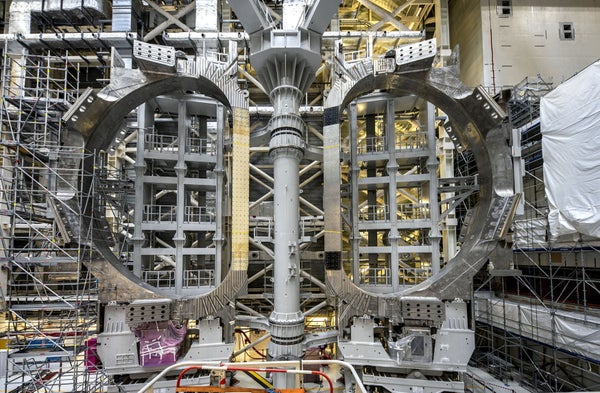For decades, scientists have tried to harness the energy released by nuclear fusion reactions because of the many potential benefits this form of energy generation would have. Now, artificial intelligence (AI) has become indispensable in unlocking the potential of nuclear fusion. This revolutionary technology offers a glimpse into a future fueled by clean, limitless energy, overcoming a significant obstacle in the pursuit of grid-scale nuclear fusion energy.
Comprehending Nuclear Fusion
Nuclear fusion involves merging two lighter elements to form a heavier one. It’s the same process that powers the sun, where hydrogen atoms collide vigorously at its core, producing helium. Here on Earth, scientists are focusing on fusing deuterium and tritium—both hydrogen isotopes. While deuterium is abundant in water, especially in oceans, tritium is rarer and primarily found in the atmosphere.
The challenge lies in recreating the sun’s extreme conditions. Fusion requires temperatures around 100 million degrees Celsius—ten times hotter than the sun’s core. Until recently, this seemed unachievable.
The Breakthrough: Controlled Fusion Ignition
In December 2022, scientists at the Lawrence Livermore National Laboratory (LLNL) achieved a historic milestone: controlled fusion ignition. Using 192 lasers, they targeted a tiny capsule containing deuterium and tritium. The lasers produced X-rays, compressing the fuel and maintaining high pressure and temperature. The result? More energy was generated from fusion than the laser energy used to drive it.
This breakthrough, known as scientific energy breakeven, marks a turning point. For the first time, we’ve produced more energy than we’ve put in. But what does this mean for clean energy?
The Promise of Limitless Clean Energy:
Abundant Fuel: Deuterium is plentiful, and tritium can be bred from lithium. Unlike fossil fuels, fusion materials won’t deplete.
Minimal Radioactive Waste: Fusion reactors produce minimal radioactive waste compared to fission reactors.
Safety: Fusion reactions cannot spiral out of control, as they require precise conditions.
No Greenhouse Gas Emissions: Fusion emits no greenhouse gases, making it a climate-friendly option.
Challenges Ahead:
While the LLNL breakthrough is monumental, challenges persist:
Sustained Ignition: Maintaining fusion ignition over extended periods is essential.
Materials Science: High temperatures degrade materials, necessitating suitable material discovery.
Economic Viability: Fusion reactors are costly to build, requiring cost-effective solutions.
AI-Enhanced Maintenance:
Artificial intelligence has become indispensable in nuclear fusion research, assisting in various ways:
Predicting Plasma Instabilities: AI models analyze real-time reactor data to forecast plasma instabilities, enabling timely adjustments to maintain plasma control.
Preventing Energy Loss: AI’s ability to prevent plasma instabilities ensures stable fusion reactions, directly impacting energy output and reactor efficiency.
Optimizing Reactor Parameters: AI fine-tunes reactor parameters to optimize fusion conditions, adapting to changing scenarios for sustained ignition.
Monitoring and Diagnostics: AI monitors reactor health, detecting anomalies and suggesting maintenance actions, minimizing downtime and maximizing reactor availability.
This latest advancement in employing AI within nuclear fusion research marks a substantial stride toward harnessing this clean, nearly boundless energy source. Through its capability to predict and manage plasma instabilities, AI has effectively tackled a significant obstacle, edging us closer to the practical application of nuclear fusion for energy generation. This progress not only bolsters the viability of fusion reactors but also holds the potential for a sustainable energy landscape.
Collaboration and Optimism:
International projects like ITER (International Thermonuclear Experimental Reactor) aim to demonstrate sustained fusion. ITER, located in France, will test fusion at scale. Private companies like TAE Technologies and Tri Alpha Energy are also pushing boundaries.

As we approach limitless clean energy, optimism prevails. Fusion could revolutionize power grids, space travel, and more. This isn’t a tale of science fiction; it’s science teetering on the edge of transformation.
Stay tuned!
![]() • Nvidia Stock Analysis: Rebound Incomi…
• Nvidia Stock Analysis: Rebound Incomi… 



